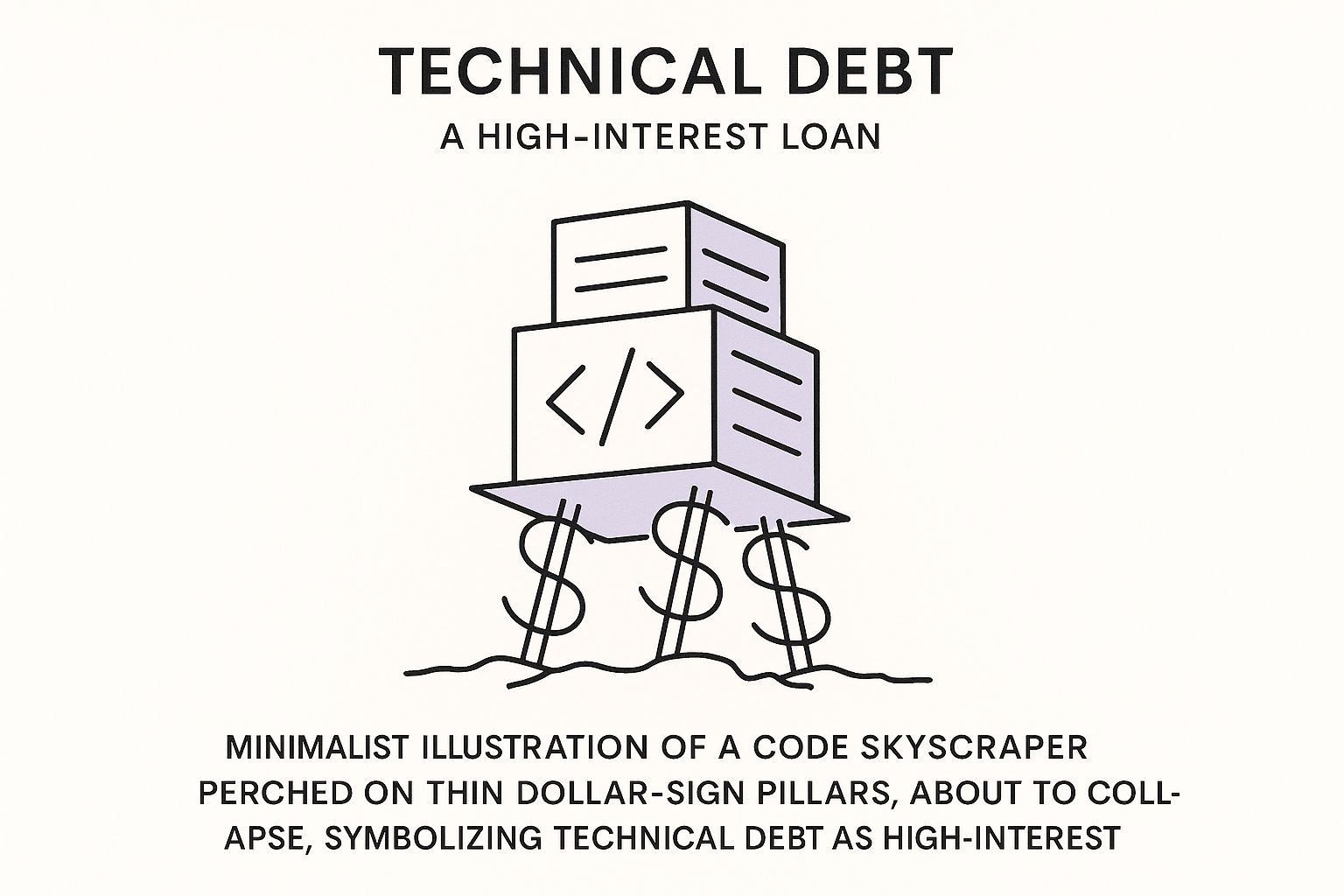
Ever feel like your software is a beautiful skyscraper built on a shaky foundation? That’s technical debt in a nutshell.
Forget the dense engineering lectures. Let's get straight to what it really means for your business, your roadmap, and your sanity.
Imagine you needed to ship a product yesterday. To make the deadline, your team took a few shortcuts in the code—maybe they hardcoded a value, skipped writing tests, or used a quick-and-dirty library. That's the principal on your loan.
Now, months later, you're paying the "interest." Every simple feature request suddenly takes weeks instead of days. Fixing one bug mysteriously creates three more. That’s the cost of those shortcuts coming back to haunt you. This isn't just an engineer's problem to solve in a dark room; it's the hidden reason your roadmap gets delayed and your best talent starts looking for the exit.
The financial loan analogy isn't just a clever metaphor; it's the most honest way to understand the business impact. The relentless pressure to deliver quickly often forces compromises that get you to market, but they come with a steep, hidden price tag. Turns out there’s more than one way to burn through your seed funding without mortgaging your office ping-pong table.

As you can see, those seemingly small shortcuts—the "dollar-sign pillars" in the infographic—can't support the weight of a growing business. Eventually, the entire structure becomes dangerously unstable.
This isn't just about messy code; it’s about a fragile system that becomes more expensive to maintain with every passing day. These issues often creep in throughout the development process. Understanding the software development life cycle explained can help pinpoint where these debts are most likely to pile up.
The real danger is that technical debt compounds silently. What starts as a "quick fix" to meet a deadline slowly morphs into a tangled mess that grinds your entire engineering team to a halt. It’s a business problem disguised as a technical one.
To make this crystal clear, here’s a quick breakdown of what technical debt looks like in the real world.
| Concept | What It Really Means | Why It Happens |
|---|---|---|
| The Shortcut | Choosing a simple, fast solution now over a better, more sustainable one. | Tight deadlines, budget pressure, or a push to get a feature out the door. |
| The "Loan" | The initial time saved by taking the shortcut. | The immediate win of launching a product or feature on time. |
| The "Interest" | The extra time and resources required later to fix issues, add features, or onboard new developers. | Slowed development, more bugs, frustrated engineers, and delayed roadmaps. |
| The "Default" | The point where the system becomes so complex and fragile that it’s nearly impossible to change. | A complete rewrite is needed, or the product stagnates and fails. |
Ultimately, every team accumulates some level of technical debt. The key isn't to avoid it entirely—that's impossible—but to manage it before the interest payments bankrupt your roadmap.
So, you’ve finally admitted you have a problem. That's the first step. But just saying you have "technical debt" is about as useful as telling a mechanic your car is "making a noise."
Is it a rusty pickup truck held together with duct tape, or is it a sleek sports car you knew would cost a fortune to maintain? They’re not the same issue, and your plan of attack shouldn't be the same either.
Technical debt isn’t one single monster; it’s a whole family of them hiding in your codebase, each with its own personality. Trying to fight them all the same way is a recipe for developer burnout and wasted sprints. You have to know your enemy.
Let's be real: not all debt is created equal. Some of it you take on with your eyes wide open, and some of it just… happens. It generally falls into a few camps.
First, there’s Deliberate Debt. This is the calculated risk, the conscious choice you make under pressure. You look your team in the eye and say, "I know this code is ugly, but we need to ship this feature before our competitor does. We’ll circle back and fix it in Q3." It's like taking out a business loan for a clear purpose—risky, but potentially smart if you actually have a repayment plan.
Then you have the much spookier Accidental Debt. This is the stuff that creeps in when no one's looking. A junior developer has a "learning moment" that goes unfixed, a once-brilliant library slowly becomes obsolete, or two well-meaning teams build features that conflict in the most bizarre ways. It’s the slow rot that happens from pure neglect.
This accidental debt is the silent killer. It’s not one big decision you can point to; it’s a thousand tiny papercuts that leave your engineering team bleeding out productivity. You don’t notice it until adding a simple button requires a full-blown forensic investigation.
Beyond why the debt happened, the what is just as important. When your developers start complaining, their grievances usually fall into one of these categories. Think of them as the specific line items on your high-interest credit card statement.
Architectural Debt: This is the big one. The foundation is cracked. Early decisions about the core structure of your software were either wrong or just haven't aged well. If your team says things like, "We can't touch that part of the code without breaking everything," you're staring at architectural rot. Fixing it is expensive and painful, like renovating the entire ground floor of your office.
Code Debt: If architecture is the foundation, code is the messy wiring and crooked walls inside. This covers everything from convoluted logic and a lack of comments explaining why something was done a certain way, to a general lack of consistency across the codebase. It’s manageable in small doses, but let it pile up, and your code becomes a hoarder’s house—impossible to navigate safely.
Documentation Debt: You built a brilliant machine, but you lost the instruction manual. Or maybe you never wrote one in the first place. New hires take forever to become productive because they have to reverse-engineer every little thing. This is how you lose the treasure map to your own product, leaving everyone to wander around in the dark.
That classic startup mantra, “move fast and break things,” looks great on a hoodie, but let’s be brutally honest—it’s a direct recipe for accumulating crippling technical debt. You’ve heard it a million times: "We'll fix it later."
But "later" never seems to arrive, and suddenly your engineering team is wading through digital quicksand.
Every shortcut, every skipped test, every "good enough for now" solution starts as a small, manageable choice. These choices compound. Soon enough, your developers spend more time fighting the system than building the new, revenue-generating features your sales team promised. Hope you enjoy fact-checking bug reports, because that’s now your full-time job.
This isn't just about lost productivity; it’s about the direct, jaw-dropping cost to your business.

Think of technical debt as an invisible tax on every single action your engineering team takes. What should be a one-day task to add a new integration point turns into a week-long archeological dig through fragile, undocumented code. This slowdown is where the real financial pain kicks in.
It’s not just a hunch, either; the numbers are staggering. In the United States alone, the economic impact of technical debt costs organizations an estimated $2.41 trillion annually. To clear that backlog would require a staggering $1.52 trillion investment.
That's the sound of innovation budgets getting eaten for breakfast. This isn't just an "IT problem"—it's the real reason your feature roadmap is perpetually delayed and your best engineers are burning out.
When your developers are spending 40% of their time working around past shortcuts, they’re not building your future. They’re patching up a sinking ship with duct tape, and your P&L statement is taking on water.
Ironically, the very methodologies designed to keep you nimble often get bogged down by debt. That "agile" team you're so proud of can only move as fast as the codebase allows.
When every sprint is half-filled with fixing mysterious bugs from two years ago, you're not agile—you're just running in place.
This constant firefighting erodes morale faster than anything else. Your top engineers, the ones who want to solve interesting problems, get stuck being digital janitors. This is precisely why it's crucial to integrate debt repayment into your workflow. If you want to keep your speed and quality in balance, check out our guide on agile methodology best practices.
Ultimately, "move fast and break things" only works if you also have a plan to "slow down and fix things." Ignore the second part, and you're not just breaking your product; you're breaking your bank account.
Let's forget about code analysis for a minute. You don't need to be an engineer to know when technical debt is out of control; you just need to look at your business operations. The symptoms are usually hiding in plain sight, masquerading as "normal" startup chaos or growing pains.
Think about the last time you asked for a "simple" change. Did your engineering lead get a haunted look in their eyes? If adding a new button to your app morphs into a two-week project that ties up three senior developers, you’re not just building features—you're performing open-heart surgery on a fragile system.

This isn't just an inconvenience. It's a giant, flashing red light. Those delays are the interest payments on your debt coming due, and they're eating your roadmap alive.
The pain isn't confined to your engineering team. It bleeds into every corner of the business, from customer support right down to your bottom line. Ask yourself if any of this sounds painfully familiar.
I once worked with a SaaS company whose onboarding flow was so brittle that a minor copy update managed to break three completely unrelated features in the billing module. The support team was flooded with tickets, sales demos failed, and customer trust evaporated. That’s the real-world cost of unmanaged debt.
The problems almost always show up as clear business symptoms:
These aren't isolated incidents. They are the direct result of a codebase groaning under the weight of past shortcuts.
When your team spends more time explaining why they can't do something than actually doing it, you're not dealing with a resource problem. You're dealing with a debt crisis.
Of course, the financial consequences are just as severe. Technical debt currently eats up a massive chunk of IT spending, with some estimates suggesting that developers spend anywhere from 25% to 50% of their time just debugging or creating workarounds. This isn't just a legacy issue; it’s an ongoing tax on your team’s efficiency. You can discover more insights about developer efficiency on jetsoftpro.com to see just how this hidden cost is impacting businesses around the globe.
This is your wake-up call. The everyday frustrations you're experiencing aren't just "how things are." They are symptoms of a deep-seated problem in your codebase, and ignoring them is a luxury you can no longer afford.
Okay, so you're finally convinced you have a problem. Now what? For most, the gut reaction is pure panic, followed by visions of freezing the entire roadmap for six months to refactor everything. Let's be clear: that's a death sentence.
You can't just stop shipping features to pay off your technical debt. Your competitors will eat your lunch, your investors will have questions, and your customers will simply leave. The goal isn't to reach "zero debt"—that’s a fantasy. The real goal is to turn an unmanaged crisis into a calculated part of your development process.
First things first: you have to make the debt visible. If it's just a vague complaint from the engineering team, it will never get prioritized over the next big feature. You need a way to show its impact to non-technical stakeholders. Think of it like a "debt-o-meter" that connects code health directly to business pain.
Is that new feature delayed by three weeks? That's not just an engineering hiccup; that’s an interest payment on your debt. Did a critical bug take down your checkout page during a Black Friday sale? Another massive payment. Start framing these incidents in terms of lost revenue, delayed opportunities, and customer churn.
The moment you start treating technical debt like a line item on your P&L, you can build a real business case for addressing it. Until then, it's just an abstract problem that will always lose to the next shiny feature request.
This problem isn’t just a feeling; it’s a global time-suck. An analysis of over 10 billion lines of code found that fixing existing technical debt would require a mind-boggling 61 billion days of work worldwide. That’s an astronomical amount of time not being spent on innovation. You can see how this widespread issue impacts the entire software world by reading the full report from CAST Software.
So, how do you actually pay it down without stopping the world? You adopt a few pragmatic, battle-tested strategies that integrate debt repayment right into your daily workflow. Forget the massive, all-or-nothing rewrite project and focus on small, incremental improvements.
Here are a few tactics that actually work:
Empowering your team to make these trade-offs is crucial. For some companies, bringing in specialized help to tackle complex refactoring can accelerate the process. Understanding the difference between staff augmentation vs consulting can help you decide which model fits best for a targeted debt-reduction initiative. This isn't about blaming the team for the mess; it's about giving them the time, tools, and authority to finally clean it up.
Let’s get brutally honest for a moment. Technical debt isn't some abstract engineering failure—it's a leadership challenge. If your codebase is a tangled mess, it’s not because your developers are slacking off. It's because the business hasn't made code health a strategic priority.
This whole conversation needs to be reframed. Accumulating some debt can be a smart, even necessary, business move. But—and this is the part leaders conveniently forget—it only works if you do it consciously.
Think about it. Launching a bare-bones MVP with known shortcuts to beat a competitor to market? That’s a good use of debt. But letting your codebase slowly rot from neglect because maintenance never makes it onto the roadmap? That’s just mismanagement. One is a calculated loan; the other is lighting money on fire.
The real shift happens when you stop seeing technical debt as a "flaw" and start treating it like a financial instrument. Just like any loan, it can be a powerful tool for growth when managed wisely. And just like any loan, it will absolutely crush you if ignored.
So, before your tech lead agrees to take on more debt to hit a tight deadline, it's your job as a leader to ask the right questions:
Treating debt strategically means making these trade-offs with your eyes wide open. It’s the difference between being a savvy investor and a gambler who doesn’t know when to walk away from the table.
We've covered a lot of ground. By now, you're probably seeing technical debt less as a monster under the bed and more as a line item on your balance sheet. Still, a few questions always pop up when founders and managers start getting serious about this stuff. Let's tackle them head-on, no fluff.
Absolutely not. Thinking all debt is bad is like thinking all financial loans are bad. A mortgage for your first office? That’s smart debt. Racking up a high-interest credit card to pay for ping-pong tables? That’s… less smart.
It’s the same with code. Strategic debt is a conscious decision—a calculated risk you take to hit a critical product launch or test a new market, always with a clear plan to repay it later.
Reckless debt, on the other hand, is the result of sloppy work and pure neglect. It’s always bad news. This kind of debt is unpredictable, compounds silently in the background, and will eventually bite you hard.
Forget trying to find a single, magic number. While some engineering tools can spit out metrics, the most telling indicators are usually found in your business operations, not just the codebase.
Start tracking how long it takes to add new features or fix simple bugs. Is a small change that should take a day now taking a week? Is that timeframe growing every quarter? That’s your debt compounding in real-time.
The most pragmatic way to measure technical debt is to just ask your development team. Frame it simply: "How many weeks would it take to fix this module so it doesn't slow us down anymore?" Their answer is your most honest metric.
This is the big one, and the answer isn't as simple as pointing a finger at the engineering department. While your engineers are on the front lines—they’re the ones who spot it and ultimately fix it—they don't own it alone.
Product managers and business leaders are responsible for prioritizing its repayment. It's a shared responsibility, but the buck really stops with leadership.
Deciding whether to take on more debt to ship a feature faster or to pay some down to improve stability isn’t a technical choice. It’s a business decision, plain and simple.
